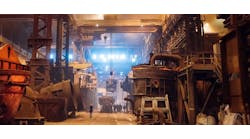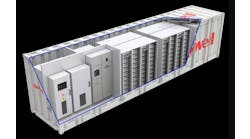After returning to pre-pandemic stability in 2021, the automation marketplace is entering a new age of growth and significant opportunities that ARC Advisory Group believes will continue well into the next decade. While the market continues to face headwinds from the war in Ukraine, rising geopolitical tensions, and continued supply chain challenges, the market experienced above average growth in 2022 and the outlook for 2023 continues to be positive.
It’s always a challenge doing the Control/ARC Top 50 story because we’re looking into the rearview mirror at financial performance from the previous year, and yet we’re already entering the fourth quarter of 2023 and the market is becoming increasingly dynamic. As we discussed last year, sustainability has emerged as the leading business issue facing both automation suppliers and end users today.
The growing adoption of digital transformation strategies, and the concurrent deployment of the Industrial Internet of Things (IIoT) suite of technologies like industrial-edge architectures and artificial intelligence (AI) are increasingly driven by sustainability initiatives. Sustainability and digital transformation are symbiotic factors that will drive growth in the automation marketplace for at least the next decade. Major automaton suppliers recognize the opportunity in sustainability, and they’re all implementing significant sustainability programs of their own, and working to provide end users with industry and application-specific solutions to help their customers to do the same. Some suppliers are already reorganizing their businesses around dimensions of sustainability.
Scope and methodology
Overall 2022 market performance
Avoiding a play-by-play analysis of each supplier’s financial performance, there’s little change in the relative positioning of the major automation suppliers in North America and worldwide. Most suppliers experienced above average growth in their automation businesses, though currency fluctuations were also a factor in 2022. All indications are that the market will perform perhaps even better in 2023, as orders and backlogs continue to increase. ARC’s quarterly analysis of automation market performance shows double-digit revenue growth in the first quarter of 2023 (1Q23) compared to the same period last year.
Sustainability impacts all industries
When most people think of sustainability, they probably think of things like electric vehicles, renewable power and recycling. However, the world’s largest hydrocarbon producers—the integrated oil and gas companies—are taking significant steps toward net-zero emissions and carbon neutrality. Chemical companies are reducing energy consumption and looking at new processes that are less energy-intensive. The water and wastewater industry and its municipalities are actively modernizing aging infrastructures. Pulp and paper companies are retrofitting plants to run without fossil fuels by using carbon-neutral biomass and residuals from their manufacturing processes. In fact, ARC challenges any reader to identify a major process, hybrid or discrete manufacturer that isn’t implementing some kind of sustainability program, whether it’s increasing energy efficiency, reducing emissions or spills, or electrifying assets that were once powered by hydrocarbons.
Any investment in new processes and technologies will have a positive impact on the automation market. Increased sustainability efforts will create new investments in a broad range of technologies from sensors to the enterprise level. Existing manufacturing processes and assets must be optimized and modified to reduce emissions, increase energy efficiency and cut costs. Wind farms, for example, are increasingly investing in industrial, edge-computing platforms. Efforts to reduce flaring and overall emissions are increasing investment in flare-control systems, pipeline corrosion-monitoring solutions and continuous emissions monitoring systems.
Other new processes that accompany sustainability include carbon-capture and storage operations, hydrogen infrastructure, improved processes for water usage and treatment, and new recycling processes for plastics and other materials. All of these create numerous greenfield opportunities for automation suppliers—if they can offer cohesive solutions. The more forward-thinking suppliers are designing solutions to address specific sustainability processes and applications.
Business value case for sustainability
It makes a lot of business sense for end users to adopt sustainability strategies. Adopting a sustainability strategy can eliminate waste by reducing emissions, eliminating oil spills and pipeline leaks, and capturing countless metric tons of methane and other substances that are usually released into the atmosphere. However, companies aren’t just focused on existing processes alone. The large. integrated oil and gas companies, for example, are transforming themselves into energy companies, making huge investments in sustainable power from wind, solar and hydrogen, and are signing long-term energy contracts with large end users such as Amazon to provide renewable energy at scale.
Asset electrification needs integrated control
The drive to sustainability has led to a mass-electrification movement of assets and processes that were previously powered by hydrocarbons. Close to 80% of the energy consumed in the chemical industry, for example, comes from fossil fuels. The opportunities for sustainability and energy efficiency by electrifying are considerable, and will require increased investment in automation. Assets like furnaces, fired heaters and more can all be electrified.
Though the Top 50 doesn’t cover items like switchgear and other electronics, the electrical side is becoming increasingly important, and the worlds of process control and electrification are integrating.
Electrical power management and automation were traditionally designed and operated independently of each other during plant lifecycles. Historically, this separation made sense. However, digital transformation enables integrated connectivity to manage these two domains going forward. The fusion of power and automation is a catalyst for operational resilience and improved sustainability across plant lifecycles, and will be a major, market-growth driver for the near future.
Regulatory environment heats up
While sustainability has a compelling business value proposition, its associated regulatory environment is ramping up, too. Governments, agencies and local officials worldwide are drafting, enacting, and enacting stricter climate policies that will have a lasting impact on multiple industries. Regulations such as the European Commission’s Corporate Sustainability Due Diligence Directive (CSDDD) will take effect in 2024, and will affect more than 50,000 businesses. These historical directives are multiplying as governments begin to lay out clear paths to net-zero, which includes a complete green energy transition.
The private sector will no longer have the option of voluntarily opting into reporting programs or climate pledges. The public sector is beginning to lay out reporting frameworks and timelines, and will rely heavily on companies to become responsible for accounting for their emissions. Suppliers and end users will be affected, but they currently have the opportunity to get ahead of the implementation of stricter energy regulations.
Inflation Reduction Act spurs automation
The recent passing of the U.S. Inflation Reduction Act (IRA) will positively impact growth of the automation market for the next several years. Contrary to its name, the law isn’t primarily intended to reduce inflation, but rather to make U.S. industries climate- and future-proof. The act provides for investments of roughly $500 billion in tax incentives, grants and loan guarantees. A large part of this funding will reduce carbon emissions and extend healthcare affordability programs, but the IRA also provides $48 billion for the manufacturing sector. Since it was signed into law, the IRA has made an immense amount of money available to end users, consumers and manufacturers. These funds are also available as tax credits, loans and grants.
The IRA also includes a 45Q tax credit of $25 to $50 per tonne (metric ton) of captured CO2 as an added incentive compared to enhanced oil recovery (EOR). The number of Class VI carbon-capture and storage applications has surged. However, only Wyoming and North Dakota have approved class VI wells so far, so there’s competition for pore space (storage locations with adequate porosity), pipelines, skilled resources, and commitments from sites generating CO2. Early projects are associated with blue hydrogen, gas processing and ethanol.
Software key to digital transformation…
Investment in software will keep increasing to meet the requirements of digital transformation. The major automation suppliers made critical investments in software capabilities in the past year. For example, Aveva completed its $5 billion acquisition of OSIsoft in 2021, while Schneider Electric completed its acquisition of Aveva in early 2023. Meanwhile, Emerson completed its acquisition of AspenTech in May 2022. Another engineering software leader, Hexagon, acquired long time independent software supplier PAS in 2020. Software is a key driving force in digital transformation, so we can expect to see more investment in software companies by major suppliers in the future.
…and so is artificial intelligence
End users are dealing with increasingly sensitive supply chains, continued conflicts in Ukraine and elsewhere, and the specter of another COVID outbreak, among others. Combinations of these and other upheavals have seemingly created a world where black swan events are abundant. The only way to become resilient and agile enough to weather these challenges is with digital transformation.
Industrial AI (including Generative AI) applies its technologies in manufacturing to augment workforces seeking growth, profitability, more sustainable products and production processes, enhanced customer service and other business outcomes. Many of the major automation suppliers are already embedding AI functions in their products and services, and we expect it to drive innovation and growth in the automation market during the coming decade.
Industrial AI leverages machine learning (ML), deep learning, neural networks and other approaches. Some of these techniques have been used for decades to build AI systems using data from various sources in industrial environments, such as sensors, machinery, process engineers and operators. AI adds to a portfolio that will expand to new systems for Causal AI, Neuro-Symbolic AI and Quantum AI as related breakthroughs occur in those fields of AI research. Industrial leaders are identifying areas where AI can make an impact, such as generative design of sustainable products, production processes and services, predictive maintenance, supply chain optimization and quality control.
OT cybersecurity and suppliers
Many of the major automation suppliers already made their cybersecurity business a priority. Generally, large automation suppliers offer cybersecurity services, such as auditing and assessments, combined with some level of lifecycle services or OT security operations center (SOC) services. Many suppliers partner with third-party OT cybersecurity suppliers for anomaly and breach detection solutions, secure remote access, zero trust, and other pieces of the industrial cybersecurity solution set that must be put together to create an integrated system for OT cybersecurity.
Suppliers need to beef up their capabilities because end users desperately need them. Adequate human resources aren’t available for OT cybersecurity. The industrial and critical infrastructure sectors can’t find enough people to meet their requirements. Similar to the wave of outsourcing automation services to suppliers in the 1990s and early 2000s, end users will increasingly rely on suppliers to deliver secure-by-design products. Users will also expect suppliers to implement security from the start of projects, and offer lifecycle services for security monitoring of operations, maintenance, configuration, SOCs, and other tasks related to OT cybersecurity. All suppliers will have to increase their cybersecurity capabilities. Approaches to OT cybersecurity are also becoming more system-focused, marking a transition from putting together a patchwork of solutions.
OPA becomes a business
Several times over the past few years, we’ve written about the impact of Open Process Automation (OPA) on the overall automation market, and the Open Process Automation Standard (O-PAS) is finally moving from conceptual and pilot project phases to commercially available products, applications and services. The vision of OPA is “to transition industry from closed and proprietary process control systems to open, secure, standards-based systems that accelerate innovation and value creation.” The objective of O-PAS is an interoperable process control architecture—taking control systems that traditionally weren’t interoperable transitioning to open and interoperable versions that spur innovation. ExxonMobil and its process industry partners in the Open Process Automation Forum (OPAF) have been advocating and advancing O-PAS for years, and they’re at a stage where they can deploy it in actual process operations. OPAF and its partners are aligning with O-PAS and forming an ecosystem.
In fact, O-PAS, Version 2.1, is now available, along with its building-block elements of communications, controls functionality and configurations, which allow suppliers to produce products and applications. The initial proof-of-concept (PoC) application by ExxonMobil was at the lab scale. At that time, O-PAS-compliant products weren’t ready for 24/7 field operations. Since then, vendors have provided commercially viable products for use in the field trials. And, as the standard matures, O-PAS will add application portability and orchestration.





